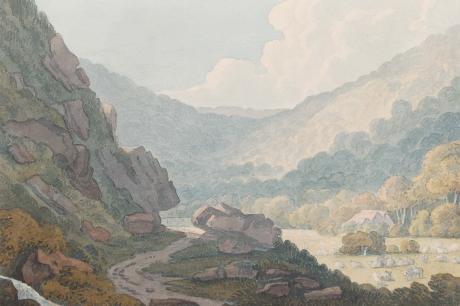Although the Hope Valley appears to be a single valley, the name of the river changes several times. The head of the valley lies below Mam Tor atCastleton. From here, the Peakshole Water flows to Hope, where it enters the lower reaches of the River Noe, which has flowed from Edale. The Noe then flows to Bamford, where it enters the River Derwent which has travelled about ten miles from Bleaklow. The valley is now technically the Derwent Valley, but the term "Hope Valley" is still used as the Derwent flows through Hathersage and Grindleford. Other streams in the area include the Burbage Brook, which runs down from Burbage through Padley Gorge and into the River Derwent near Grindleford station.
The area is a popular tourist destination, particularly as the Hope Valley Line railway from Sheffield to Manchester runs through it, from the western end of the Totley Tunnel near Grindleford to the eastern end of the Cowburn Tunnel near Edale.
In the centre of the valley is a long-established cement factory, the UK's biggest, run by Hope Construction Materials.It is somewhat infamous locally because it is a prominent industrial operation in the middle of a National Park, and very visible from many locations. However the factory provides valuable local employment that is outside of the tourism sector.
The Hope Valley College is the only secondary school in the Hope Valley. There is a Christian theological college in the valley, Cliff College.
There is evidence that Hope has been extremely significant in the region throughout its long history. The village is mentioned in the Domesday Book of 1086 as having both a priest and a church, the only place in north Derbyshire to have such status at the time. St. Peter's Church, opposite the Old Hall public house, dates from around the 13th century.
The parish of Hope covered two thirds of the Royal Hunting Forest of north Derbyshire and was one of the largest parishes in the country. From earlier times there are traces of a Roman fort at Brough, just to the east of the village. Its Roman name Navio was later replaced with the Old English word for fort, Brough. Many ancient relics from the site can be seen in Buxton Museum. It is thought that the fort was probably built to protect Roman lead-mining interests in the Peak District.
The village is built on the crossroads of the A6187 Sheffield to Chapel-en-le-Frith road, and the B6049 that runs northward from Tideswell to Edale. This minor road closely follows the route of the old Portway, which was an ancient trading route used by Jaggers, a local term for men driving packhorses carrying salt and other goods from Cheshire. Names such as Saltergate Lane and Jaggers Lane probably originate from this period.

